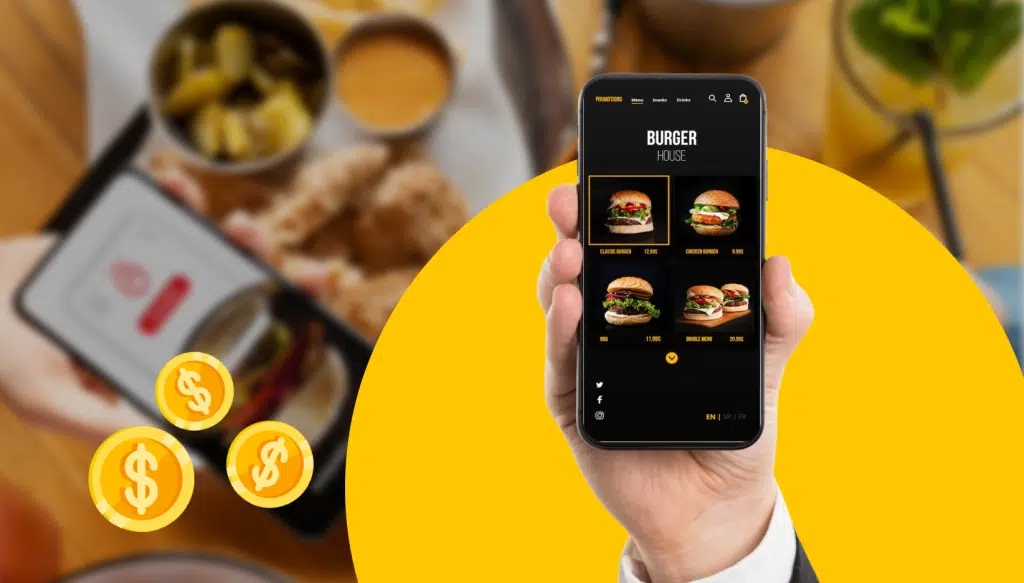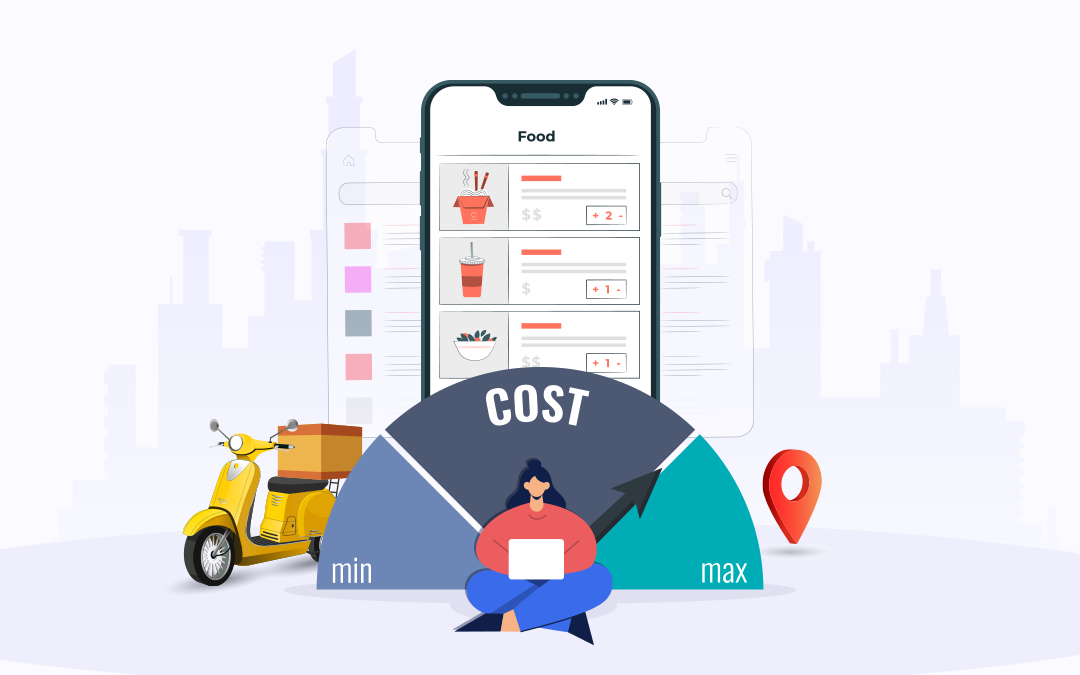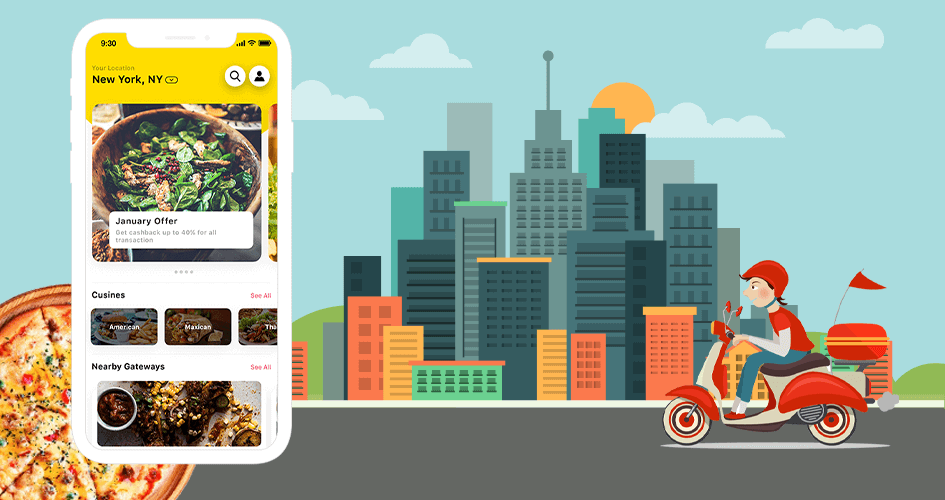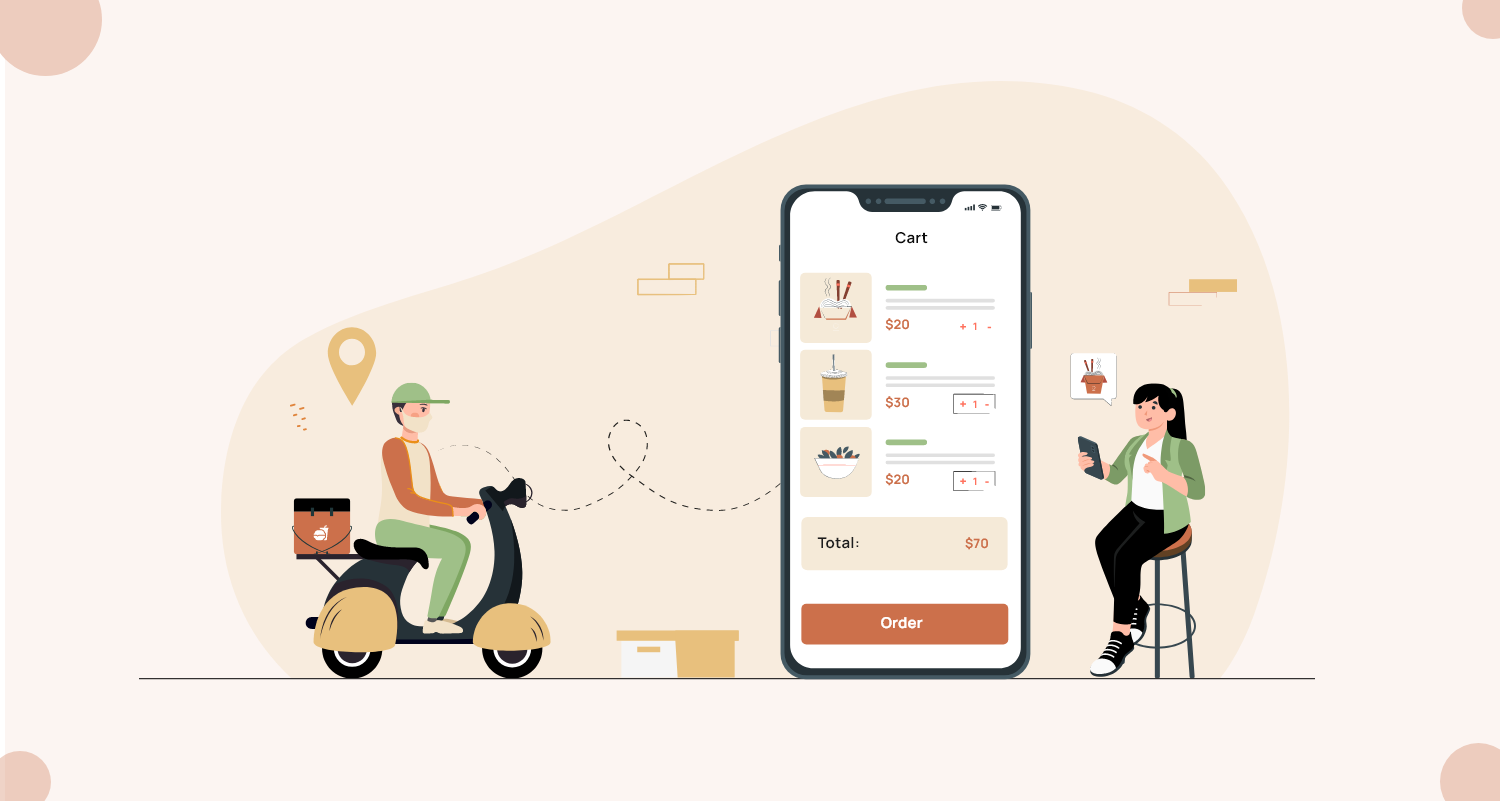Technology has revolutionized numerous industries, and food delivery is no exception. The digital dimension it brings to the business is evident in the booming popularity of food delivery apps. This upward trend is further fueled by recent events like the COVID-19 pandemic, which drastically shifted consumer behavior towards convenient, contactless options. This surge in demand makes food delivery app development a compelling prospect for startups.
In this guide, we’ll delve into the key areas of mobile food delivery, exploring current trends and features that will empower you to create a successful app in 2024.
But before diving in, let’s explore how the pandemic reshaped the food delivery landscape and the changes that emerged to meet the evolving needs of customers.
Food Delivery Landscape in 2024
While the food delivery industry experienced impressive growth before 2020, many major players faced challenges. Big names like DoorDash, Postmates, and Uber Eats explored potential mergers, but talks never materialized. Then, a global pandemic struck, completely transforming the landscape.
During lockdowns, food delivery services saw a meteoric rise. People prioritized contactless delivery for essential items like groceries and meals. This period unlocked immense potential for on-demand food delivery businesses.
Though industry giants might seem dominant, the market is not a closed ecosystem. The pandemic witnessed a surge in on-demand food delivery startups worldwide, and their popularity continues to grow.
Take Glovo, a Spanish startup partnering with local businesses to deliver restaurant takeout, groceries, and more. They secured a significant funding of $528 million. Similarly, Gousto, a UK meal-kit service, capitalized on the situation, raising $41 million during the lockdown period.
Gorillas, a unique startup aiming for ten-minute delivery of groceries, surpassed initial valuations by securing a whopping $290 million in funding. These examples showcase the thriving environment for innovative food delivery app development in 2024.
The Future of Food Delivery
While predicting the future with absolute certainty is impossible, advancements in technology are constantly reshaping our world. In the realm of food delivery, these advancements are making “one-touch” convenience a reality.
The current boom in online food delivery services is undeniable. However, it’s important to recognize that this growth may not be entirely sustainable in the long term. As the pandemic’s influence wanes, the surge in delivery usage might stabilize. However, on-premise dining is also expected to experience continued growth even after the pandemic subsides.
Supporting this notion, data from Datassential (September 2020) reveals that a significant portion (59%) of food delivery users expressed a desire to continue using these apps even after the pandemic ends. This suggests a strong foundation for continued app usage even as overall delivery volume potentially adjusts.
Contactless Delivery: A Rising Trend
The intersection of artificial intelligence (AI) and advancements in drone and robot technology has the potential to revolutionize food delivery by enabling contactless options.
Driven by the need to maintain safety and hygiene during the pandemic, the industry experimented with various contactless delivery methods. This included a shift from cash-on-delivery to cashless payment options, facilitating a seamless and touch-free exchange. These contactless methods minimize unnecessary interactions and reduce the risk of exposure, making them a popular choice among customers.
Given the clear customer preference for contactless delivery, it’s evident that this trend has firmly established itself in the food delivery landscape. Now that we’ve explored some key market insights, let’s delve into the various business models that power on-demand food delivery apps.
Business Models for Food Delivery Apps
Before diving into food delivery app development, it’s crucial to understand the three main business models available. Each offers unique advantages, so let’s explore them to find the best fit for your vision.
1. Platform-to-Consumer Model:
This model connects customers directly with restaurants, allowing them to browse menus and order food seamlessly through your app. Think of popular services like Uber Eats or DoorDash. Restaurants manage their own delivery fleets in this model.
The platform-to-consumer model is attractive due to its potential for high profitability. Your app generates revenue from both customers and restaurants. Customers typically pay a delivery fee, while restaurants might pay a commission on each order. For restaurants, it offers a convenient way to reach new customers and automate order processing, replacing traditional phone orders.
2. Delivery Service Aggregators:
This model acts as a middleman between customers and multiple restaurants in your local area. Similar to the platform-to-consumer model, it connects users with restaurants and facilitates orders. However, aggregators often provide additional customer support, acting as a point of contact for any delivery or order issues. Here, your app earns revenue by charging a commission on each completed transaction.
GrubHub, JustEat, and Delivery Hero are examples of successful food delivery platforms using this model. Some aggregators even experiment with subscription services, where customers pay a monthly fee for benefits like discounts or free deliveries.
3. Restaurant-to-Consumer Model:
This model focuses on restaurants that deliver food directly to customers from their own kitchens. Familiar brands like McDonald’s, Burger King, and Domino’s are prime examples. While these restaurants traditionally had their own delivery systems, many have embraced mobile apps and online ordering platforms to modernize the process. Additionally, they might partner with existing delivery services like DoorDash to expand their reach without managing their own fleet.
Domino’s, a true game-changer in the food delivery industry, has pioneered innovative solutions. They’ve implemented a voice recognition system for ordering, a mobile app for order tracking, and are even exploring drone deliveries for the future.
By understanding these business models, you can choose the approach that best aligns with your target audience and overall vision for your food delivery app development project.
Must-Have Features for Your Food Delivery App
Here’s a breakdown of the essential features you need to consider when developing a food delivery app, catering to customers, restaurants, and delivery drivers.
Customer App Features:
- Effortless Search and Filtering: Allow users to easily search and browse restaurants by location, cuisine type, or specific dishes.
- Seamless Ordering: Customers should be able to place orders with just a few clicks. This includes selecting items, adding them to a cart, and finalizing the order.
- Real-time Order Tracking: Keep customers engaged by providing a live map view of their order’s progress. This transparency builds trust and allows them to see estimated delivery times.
- Secure Payment Gateway: Integrate secure payment options like debit/credit cards and online banking for a smooth checkout experience. This also guarantees restaurants receive payments efficiently.
- Review and Rating System: Encourage customer feedback by allowing them to rate and review restaurants and the overall app experience. This valuable data helps you improve your service and attract new customers.
- Order History Management: Save users time with an order history feature. This allows them to easily revisit past orders and reorder favorites with minimal effort.
- Discover Nearby Restaurants: Help users find great food options nearby with a location-based search function. This feature should display menus, prices, reviews, and allow them to order directly.
Delivery Driver’s App Features:
- Simple Registration: Offer a hassle-free signup process for drivers using phone numbers, email, or social media accounts. This streamlines onboarding and encourages new driver enrollment.
- Customizable User Profile: Allow drivers to create a profile with their name, contact details, and photo for transparency. This basic information helps users feel more comfortable with the delivery process.
- Order Alerts and Notifications: Ensure drivers are always informed about new orders with timely alerts and notifications. Even when the app isn’t actively in use, sound alerts should notify them of new requests.
- Efficient Delivery Management: Empower drivers to handle multiple deliveries simultaneously. This feature allows them to accept orders that fit their existing routes, optimizing delivery efficiency.
- GPS Navigation Integration: Equip drivers with a reliable GPS map system. This suggests the most convenient routes, saving them time and ensuring timely deliveries, especially for last-minute order pickups.
- In-App Communication: Facilitate communication between drivers and customers with an integrated chat or call option. This allows them to address any delivery issues or questions that may arise.
- Delivery History Tracking: Provide drivers with a clear overview of their past deliveries and payment records within the app.
Admin Dashboard Features:
- Comprehensive Performance Analysis: Gain valuable insights into user activity and delivery performance. Monitor food deliveries, track driver performance, analyze scheduled and canceled orders, and access driver information – all from a centralized dashboard.
- Simplified Order Management: Oversee the entire order lifecycle, from restaurant pickups to deliveries and scheduled orders. This feature ensures smooth order processing and timely deliveries to customers.
- Real-time Updates and Monitoring: Maintain complete control by receiving real-time updates about drivers and restaurants. This includes profile changes, restaurant operating hours, and availability updates.
- Financial Management Tools:S implify payment processing and commission management for both drivers and restaurants through a dedicated admin interface. This ensures transparency and timely payouts.
- Promotional Tools: Attract new customers and boost orders with the ability to offer discounts and coupon codes directly through the app.
- Push Notification System: Stay informed with push notifications for key events like drivers accepting orders and beginning deliveries.
- Restaurant Management Console: Grant the admin complete control over restaurants listed on the app. This includes adding new restaurants, removing inactive ones, and managing their overall presence within the app.
- Marketing Campaign Management: Run and manage targeted marketing campaigns via email, SMS, and social media platforms directly through the admin dashboard. This allows you to reach a wider audience and promote your food delivery app effectively.
By incorporating these essential features, you can create a food delivery app that caters to all stakeholders – customers, restaurants, and drivers – leading to a successful and user-friendly platform.
Revenue Models for Your Food Delivery App
Food delivery apps offer several ways to generate income. Here are some popular models to consider when developing your food delivery app:
1. Commission Fees:
This model lets you earn a commission on each order placed through your app. Restaurants essentially pay you a percentage of the total order value for connecting them with customers. This incentivizes you to promote a wide variety of restaurants and attract a large user base.
2. Subscription Model:
With subscriptions, restaurants pay a recurring fee (monthly or yearly) to list their offerings on your platform. This provides a stable income stream and encourages restaurants to maintain a strong presence on your app.
3. In-App Advertising:
This model allows restaurants to pay for premium placement within your app. You can highlight featured restaurants, specific dishes, or special offers. This is particularly effective for established restaurants looking to boost their visibility to a large audience. As your user base grows, consider offering tiered ad packages to cater to different restaurant budgets.
4. Delivery and Service Charges:
You can charge customers a delivery fee, especially if you manage your own delivery network. This helps offset operational costs and ensures a sustainable business model. Additionally, explore surge pricing during peak hours. This allows restaurants to pay a higher commission for faster order processing, potentially reducing wait times for your customers.
By implementing a combination of these revenue models, you can create a financially viable food delivery app that benefits both restaurants and users. Remember, the ideal model depends on your target market, operational setup, and long-term goals.
Building Your Food Delivery App: Tools and Technologies
Now that you understand the essential features for your food delivery app, let’s delve into the world of tools and technologies that bring it to life. Here’s a breakdown of the key components to consider for both Android and iOS development:
Development Foundation:
- Programming Languages: For Android, popular choices include Java and Kotlin, while Swift and Objective-C are the primary languages for iOS development.
- Development Tools: Android Studio and the Android Developer Tools provide a comprehensive environment for building Android apps. Apple Xcode serves as the primary development platform for iOS apps.
- Software Development Kits (SDKs): The Android SDK and iOS SDK offer essential tools and libraries specifically designed for building mobile applications on their respective platforms.
Integrations for Seamless Functionality:
- APIs and Services: These building blocks allow your app to connect with various external services, enabling functionalities like location tracking, social media logins, and payment processing.
- Communication: Integrating mailing services like Gmail or SendGrid allows for sending important notifications and updates to users. Push notification services like Twilio or Firebase Cloud Messaging ensure real-time communication between customers, drivers, and restaurants.
- Social Media Integration: Connecting your app with popular social media platforms like Facebook or Instagram allows users to easily share their experiences and potentially attract new customers.
- Payment Processing: Seamless integration with secure payment gateways like Stripe or PayPal ensures a smooth and convenient checkout experience for users.
- Restaurant Data: APIs from platforms like GrubHub or Zomato can simplify restaurant discovery and menu integration within your app.
- Location Tracking: MapKit on iOS allows for real-time location tracking, a crucial feature for both customers and delivery drivers.
By carefully selecting the right tools and technologies, you can lay a strong foundation for your food delivery app, ensuring a feature-rich and user-friendly experience for everyone involved.
Food Delivery App Development Cost
The final cost of building your food delivery app can vary depending on several factors. Here’s a breakdown of some key elements that can influence your budget:
- Features and Functionalities: The more features you pack into your app, the higher the development cost. Consider prioritizing core functionalities like browsing menus, placing orders, and real-time order tracking. Advanced features like in-app chat or loyalty programs can be added later as your business grows.
- Project Scope and Planning: A well-defined project scope helps developers understand your vision and estimate costs accurately. This includes outlining the app’s functionalities, target platforms (Android, iOS, or both), and desired user experience.
- UI/UX Design: A user-friendly and visually appealing interface is crucial for a successful food delivery app. Investing in strong UI/UX design ensures a smooth and intuitive user experience, potentially reducing development time and costs in the long run.
- Development Platforms: Will your app be available on Android, iOS, or both? Developing for multiple platforms generally means double the development effort (and cost). Consider your target audience and prioritize the platform they use most.
- Deployment and Maintenance: Launching your app is just the first step. Ongoing maintenance is essential for fixing bugs, updating features, and ensuring smooth operation. Factor in the cost of ongoing maintenance when planning your budget.
- Security Measures: It is critical to protect user data and financial information. Implementing robust security features adds to the development cost, but it’s a crucial investment for building trust with your users.
- Development Team: The experience and location of your development team can significantly impact the overall cost. Hiring a team of experienced developers will likely be more expensive, but it can also ensure higher quality and faster development.
By carefully considering these factors, you can create a realistic budget for your food delivery app development project. Remember, striking a balance between features, functionality, and cost is key to building a successful app within your financial constraints.
Conclusion
So, you’ve decided to enter the exciting world of food delivery apps! But before diving in, it’s crucial to conduct thorough market research and gain a deep understanding of the industry. A well-defined budget is also essential for success.
This guide has equipped you with valuable knowledge about key elements for developing a food delivery app. We’ve explored various features to consider, different business models to navigate, and potential revenue streams to explore. Additionally, we’ve shed light on the technologies that power these successful apps.
Remember, the key to a thriving food delivery app lies in targeting the right market. Clearly define your ideal customer base, identify the challenges they face, and tailor your app’s functionalities to address them. With a well-defined target audience and a clear vision for your app’s purpose, you’ll be well on your way to developing a solution that stands out in the competitive food delivery landscape.
Looking for a development partner to bring your food delivery app to life? We’re here to help! Here at Onextdigital, our team of experienced mobile app developers is passionate about assisting food businesses in establishing a strong online presence. Regardless of your company’s size, we offer comprehensive development services to create a feature-rich food delivery app that caters to your specific needs. Contact us today, and let’s discuss how we can turn your food delivery app vision into a reality.









